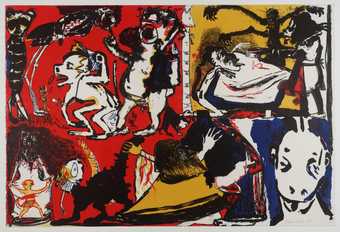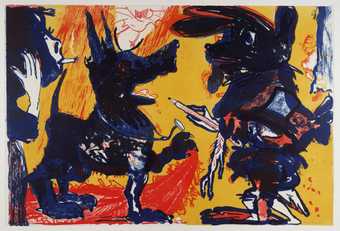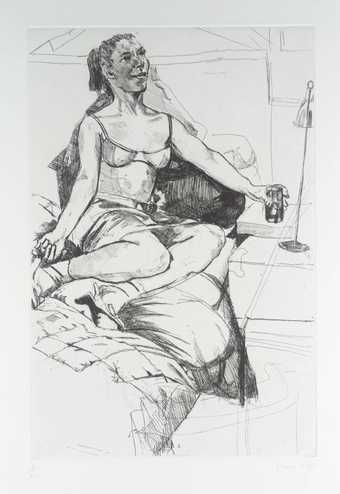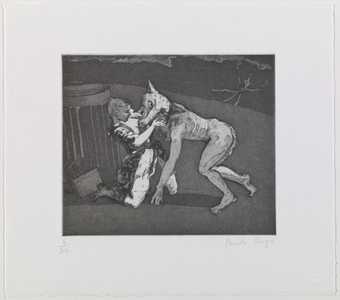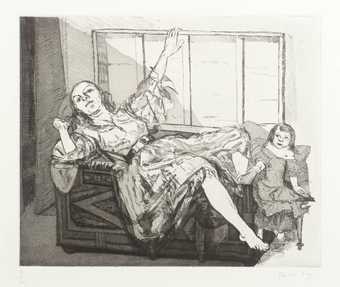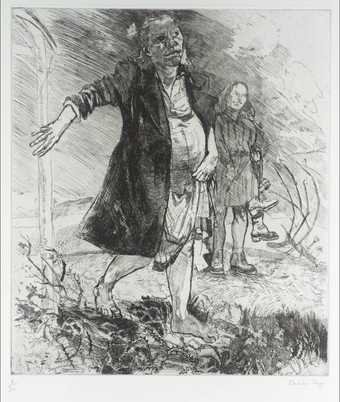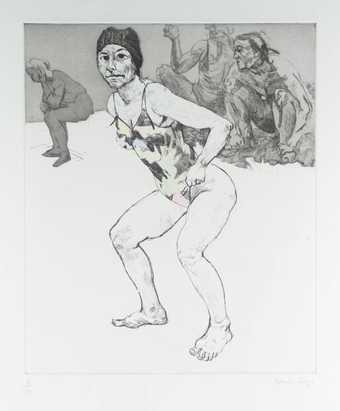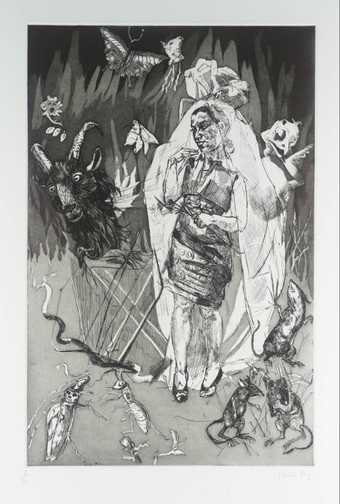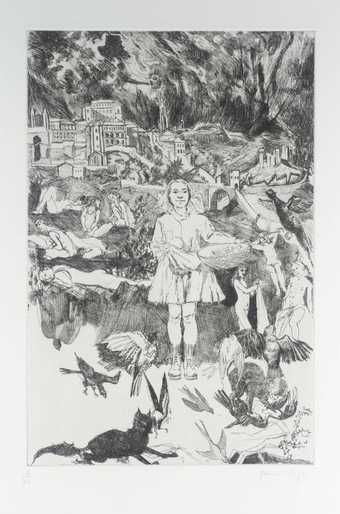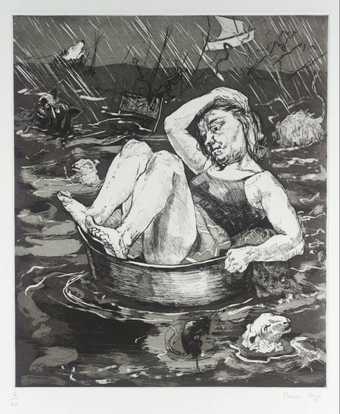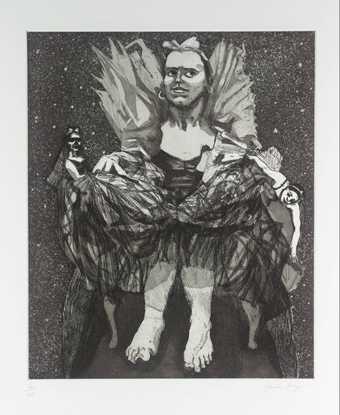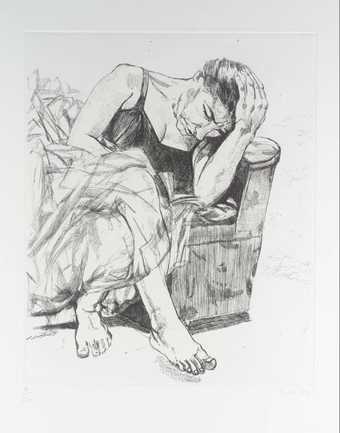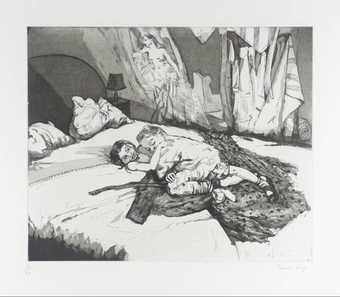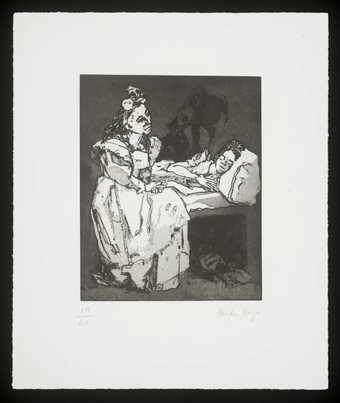Sorry, no image available
In Tate Britain
Prints and Drawings Room
View by appointment- Artist
- Paula Rego 1935 – 2022
- Part of
- Abortion Series
- Medium
- Etching on paper
- Dimensions
- Image: 200 × 295 mm
- Collection
- Tate
- Acquisition
- Presented by the artist 2002
- Reference
- P20239
Summary
This etching is one of a series of powerful works the artist made on the subject of abortion. The prints were produced in an edition of seventeen; Tate owns one of two sets of artist’s copies of seven of them. In addition to the etchings, Rego made a number of drawings and paintings, including the large scale Triptych, 1998 (Marlborough Fine Art, London). Each of the images shows a young woman alone in a room either during or immediately after an abortion.
Rego made these images in response to a referendum on abortion that took place in her native Portugal on 28 June 1998. Portugal, a predominantly Catholic country, has restrictive laws on abortion, allowing it only in specific cases: danger to the life of the mother, incurable illness of the foetus or if the pregnancy was the result of rape. This conservative stance is historic, dating back to the criminalisation of abortion under President António de Oliveira Salazar, whose dictatorship ran from 1932-68. In 1998 a proposal to liberalise the law was approved by Parliament, allowing termination on demand up to ten weeks. A coalition backed by the Church demanded a referendum on the issue. Just under 32% of the population voted, and the proposed change was defeated by less than two percentage points, with 50.92% voting against. In effect, this result blocked the passage of the law (see Lisboa, pp.143-5). Rego was dismayed by the outcome, and galvanized to make work in response. She has said, ‘I got so angry because I’d seen it all in Portugal – the suffering that went on when abortion was totally illegal. It was mind-boggling’ (quoted in ‘Paula Rego interviewed by Edward King, February 2001’, Celestina’s House, p.11).
The women Rego depicts in the series are in domestic surroundings, suggesting that theirs are illegal backstreet abortions. Their bodies and faces are contorted in pain but the women remain stoic and strong, defiant in their right to choose to terminate their pregnancies regardless of whether the church and state approve. Rego emphasises the fact that each woman is alone, framing each one starkly and keeping additional visual information to a minimum. The focus of these images is the women’s physical and mental anguish. Rego avoids sensationalism by declining to display blood and gore. She said, ‘I tried to do it full frontal but I didn’t want to show ... anything to sicken, because people wouldn’t look at it then. And what you want to do is make people look ... make it agreeable, and in that way make people look at life’ (quoted in Celestina’s House, p.11). Her project was directly political and her intention from the outset was to exhibit these images in Portugal. Etchings, pastels and drawings on the subject were shown at the Fundação Calouste Gulbenkian in Lisbon in 1999 and images from the series have since been used to illustrate press articles about the issue of abortion.
In this image a woman lies on a chaise longue, her legs propped up on an armchair positioned at the foot of the daybed. She is naked from the waist down, and has pushed her top up so that it lies in folds over her breasts. She holds a cloth to her abdomen, just below her navel. Her head is thrown back and she stares at the ceiling in a death-like pose, recalling some of the victims in the Disasters of War etchings, 1863 (Real Academia de Bellas Artes de San Fernando, Madrid) by Francisco de Goya (1746-1828). As if to counter this stillness there is a sense of movement in the woman’s elongated foot pressed against the densely cross-hatched chair. A wristwatch lies on the floor, its face in shadow, suggesting the length of time the procedure has taken. Rego has spoken about her desire to depict the woman in this series with compassion, highlighting their determination. She has said, ‘those who resort to abortion can do no more. I am not a moralist. I draw attention to suffering’ (quoted in Lisboa, p.185).
Further reading:
Fiona Bradley and Edward King, Paula Rego: Celestina’s House, exhibition catalogue, Abbot Hall Art Gallery, Kendal, 2001, reproduced no.15 in colour.
Fiona Bradley, Paula Rego, London, 2002.
Maria Manuel Lisboa, Paula Rego’s Map of Memory: National and Sexual Politics, Burlington, Vermont, 2003.
Rachel Taylor
November 2003
Does this text contain inaccurate information or language that you feel we should improve or change? We would like to hear from you.
You might like
-
Paula Rego Lessons
1982 -
Paula Rego Doctor Dog
1982 -
Paula Rego Pomagne
1996 -
Paula Rego Him
1996 -
Paula Rego Moth
1996 -
Paula Rego Whinney Moor
1996 -
Paula Rego Pendle Witches
1996 -
Paula Rego Straw Burning
1996 -
Paula Rego A Concise Definition of Answers
1996 -
Paula Rego Flood
1996 -
Paula Rego Mist I
1996 -
Paula Rego Mist II
1996 -
Paula Rego Mist III
1996 -
Paula Rego Mist IV
1996 -
Paula Rego The Guardian
2008

